C/2015 XY1 Lemmon
more info
Comet C/2015 XY1 was discovered on 4 December 2015 with Mount Lemmon survey, that is about 2.4 yr before its perihelion passage, and was observed until 1 January 2020.
Comet had its closest approach to the Earth on 27 December 2017 (6.984 au); about 4 months before its perihelion passage.
Solutions given here are based on data spanning over 4.88 yr in a range of heliocentric distances from 9.52 au 7.928 au (perihelion) – 9.62 au.
This Oort spike comet suffers slight planetary perturbations during its passage through the planetary system; however, these perturbations can lead to escape the comet from the planetary zone on a marginally hyperbolic orbit (see future barycentric orbit for solution ra).
See also Królikowska and Dones 2023.
Comet had its closest approach to the Earth on 27 December 2017 (6.984 au); about 4 months before its perihelion passage.
Solutions given here are based on data spanning over 4.88 yr in a range of heliocentric distances from 9.52 au 7.928 au (perihelion) – 9.62 au.
This Oort spike comet suffers slight planetary perturbations during its passage through the planetary system; however, these perturbations can lead to escape the comet from the planetary zone on a marginally hyperbolic orbit (see future barycentric orbit for solution ra).
See also Królikowska and Dones 2023.
| solution description | ||
|---|---|---|
| number of observations | 408 | |
| data interval | 2015 12 04 – 2018 03 16 | |
| data arc selection | data generally limited to pre-perihelion (PRE) | |
| range of heliocentric distances | 9.52 au – 7.93au | |
| detectability of NG effects in the comet's motion | NG effects not determinable | |
| type of model of motion | GR - gravitational orbit | |
| data weighting | YES | |
| number of residuals | 804 | |
| RMS [arcseconds] | 0.30 | |
| orbit quality class | 1a+ | |
| previous orbit statistics, both Galactic and stellar perturbations were taken into account | ||
|---|---|---|
| no. of returning VCs in the swarm | 5001 | * |
| no. of escaping VCs in the swarm | 0 | |
| no. of hyperbolas among escaping VCs in the swarm | 0 | |
| previous reciprocal semi-major axis [10-6 au-1] | 27.10 – 27.73 – 28.41 | |
| previous perihelion distance [au] | 330 – 400 – 530 | |
| previous aphelion distance [103 au] | 69.9 – 71.7 – 73.5 | |
| time interval to previous perihelion [Myr] | 6.82 – 7.23 – 7.44 | |
| percentage of VCs with qprev > 20 | 100 | |

Upper panel: Time distribution of positional observations with corresponding heliocentric (red curve) and geocentric (green curve) distance at which they were taken. The horizontal dotted line shows the perihelion distance for a given comet whereas vertical dotted line — the moment of perihelion passage.
Middle panel(s): O-C diagram for a given solution (sometimes in comparison to another solution available in CODE), where residuals in right ascension are shown using magenta dots and in declination by blue open circles.
Lowest panel: Relative weights for a given data set(s).
Middle panel(s): O-C diagram for a given solution (sometimes in comparison to another solution available in CODE), where residuals in right ascension are shown using magenta dots and in declination by blue open circles.
Lowest panel: Relative weights for a given data set(s).
| previous_g orbit statistics, here only the Galactic tide has been included | ||
|---|---|---|
| no. of returning VCs in the swarm | 5001 | * |
| no. of escaping VCs in the swarm | 0 | |
| no. of hyperbolas among escaping VCs in the swarm | 0 | |
| previous reciprocal semi-major axis [10-6 au-1] | 29.74 – 30.59 – 31.43 | |
| previous perihelion distance [au] | 15.8 – 16.7 – 17.8 | |
| previous aphelion distance [103 au] | 63.6 – 65.4 – 67.2 | |
| time interval to previous perihelion [Myr] | 5.71 – 5.94 – 6.21 | |
| percentage of VCs with 10 < qprev < 20 | 100 | |